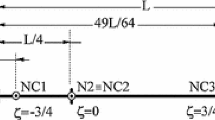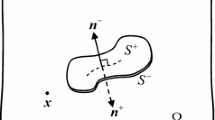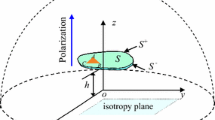Abstract
This paper concerns the determination of singular electromechanical stress field in piezoelectrics. A one-dimensional finite element procedure is generalized to compute the eigensolutions of the singular electromechanical field. The generalized procedure is capable of taking differently poled piezoelectrics, cracks and ultra-thin electrodes into account. To determine the strength of the singular electromechanical stress field, the hybrid-Trefftz finite element method is adopted. The independently assumed electromechanical stress modes are extracted from the eigensolutions previously computed from the one-dimensional procedure. Since the eigensolutions satisfy all the balance conditions, the hybrid-Trefftz models can be constructed by boundary integration. This feature enables the models to be interfaced compatibly with conventional finite element models. To illustrate the efficacy of the present approach, the eigensolutions and/or parameters directly related to the electromechanical stress intensity in crack, interfacial crack and bimorph with embedded electrode are considered. The predictions are in good agreement with the reference solutions reported in the literature or computed by using over 10,000 conventional finite elements.
Similar content being viewed by others
References
ABAQUS (2001) ABAQUS Theory and user’s manuals, version 6.2. Hibbitt, Karlsson & Sorensen, Inc., Pawtucket, Rhode Island, USA
Atluri SN, Kobayashi AS, Nakagaki M (1975). An assumed displacement hybrid finite element method for fracture mechanics. Int J Fract 11:257–271
Beom HG, Atluri SN (2002). Conducting cracks in dissimilar piezoelectric media. Int J Fract 118:285–301
Chen MC, Sze KY, Wang HT (2001). Analysis of singular stresses in bonded biomaterial wedges by computed eigen solutions and hybrid element method. Commun Numer Methods Eng 17:495–507
Dunn ML (1994) The effects of crack face boundary conditions on the fracture mechanics of piezoelectric solid. Eng Fract Mech 48:25–39
Eernisse EP (1967) Variational method for electrostatic vibration analysis. IEEE Trans Sonics Ultrasonics 14:153–160
Freitas JA, Ji ZY (1996) Hybrid-Trefftz equilibrium model for crack problems. Int J Numer Methods Eng 39:569–584
Gao CF, Wang MZ (2000) Collinear permeable cracks between dissimilar piezoelectric materials. Int J Solid Struct 37:4969–4986
Hao TH, Shen ZY (1994) A new electric boundary condition of electric fracture mechanics and its applications. Eng Fract Mech 47:793–803
IMSL (1997) IMSL Math/Library, Visual Numerics, Texas
Kuo CM, Barnett DM (1991). Stress singularities of interfacial cracks in bonded piezoelectric half-spaces. In: Wu JJ, Ting TCT, Barnett DM (eds). Modern theory of anisotropic elasticity and applications. SIAM, Philadelphia, pp. 33–50
Lee J, Gao HJ (1995) A hybrid finite element analysis of interface cracks. Int J Numer Methods Eng 38:2465–2482
McMeeking RM (1989) Electrostrictive stresses near crack-like flaws. J Appl Math Phys 40:615–627
Ou ZC, Wu XJ (2003) On the crack-tip stress singularity of interfacial cracks in transverse isotropic bimaterials. Int J Solids Struct 40:7499–7511
Pak YE (1990) Crack extension force in a piezoelectric material. J Appl Mech 57:647–653
Park SB, Sun CT (1995) Effect of electric field on fracture of piezoelectric ceramics. Int J Fract 70:203–216
Parton VZ (1976) Fracture mechanics of piezoelectric materials. Acta Astronautica 3:671–683
Pian THH, Tong P, Luk CH (1971) Elastic crack analysis by a finite element method. In: Proceedings of 3rd conference on matrix methods in structural mechanics, Wright-Patterson Air Force Base, AFFDL- TR-71–160, pp 661–682
Pian THH, Chen DP (1983) On the suppression of zero energy deformation modes. Int J Numer Methods Eng 19:1741–1752
Pian THH, Wu CC (1988) A rational approach for choosing stress terms for hybrid finite element formulations. Int J Numer Methods Eng 26:2331–2343
Piltner R (1985) Special finite elements with holes and internal cracks. Int J Numer Methods Eng 21:1471–1485
Qin QH (2003) Variational formulations for TFEM of piezoelectricity. Int J Solids Struct 40:6335–6346
Qin QH, Yu SW (1997) An arbitrary-orientated plane crack terminating at the interface between dissimilar piezoelectric materials. Int J Solids Struct 34:581–590
Ru C (2000a) Electrode-ceramic interfacial cracks in piezoelectric multilayer materials. J Appl Mech 67:255–261
Ru C (2000b) Exact solution for finite electrode layers embedded at the interface of two piezoelectric half planes. J Mech Phys Solids 48:693–708
Sosa H (1992) On the fracture mechanics of piezoelectric solids. Int J Solids Struct 29:2613–2622
Sosa HA, Pak YE (1990) Three-dimensional eigenfunction analysis of a crack in a piezoelectric material. Int J Solids Struct 26:1–15
Suo Z, Kuo CM, Barnett DM, Willis JR (1992) Fracture mechanics for piezoelectric ceramics. J Mech Phys Solids 40:739–765
Sze KY, Pan YS (1999) Hybrid piezoelectric finite element models for three-dimensional analysis. J Sound Vibrat 226:519–547
Sze KY, Wang HT, Fan H (2001) A finite element approach for computing edge singularities in piezoelectric materials. Int J Solids Struct 38:9233–9252
Sze KY, Yang XM, Yao LQ (2004) Stabilized plane and axisymmetric piezoelectric finite element models. Finite Elem Anal Des 40:1105–1122
Wang TC, Han XL (1999) Fracture mechanics of piezoelectric materials. Int J Fract 98:15–35
Xue WM, Karlovitz LZ, Atluri SN (1985) On the existence and stability conditions for mixed- hybrid finite element solutions based on Reissner’s variational principle. Int J Solids Struct 21:97–116
Author information
Authors and Affiliations
Corresponding author
Rights and permissions
About this article
Cite this article
Wang, H.T., Sze, K.Y. & Yang, X.M. Analysis of Electromechanical Stress Singularity in Piezoelectrics by Computed Eigensolutions and Hybrid-trefftz Finite Element Models. Comput Mech 38, 551–564 (2006). https://doi.org/10.1007/s00466-005-0026-5
Received:
Accepted:
Published:
Issue Date:
DOI: https://doi.org/10.1007/s00466-005-0026-5




